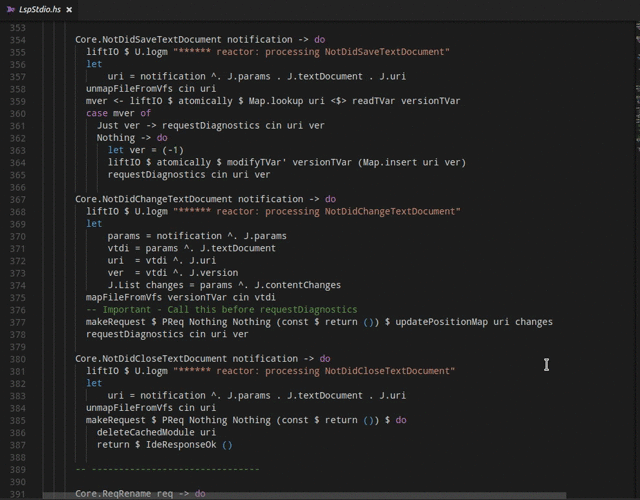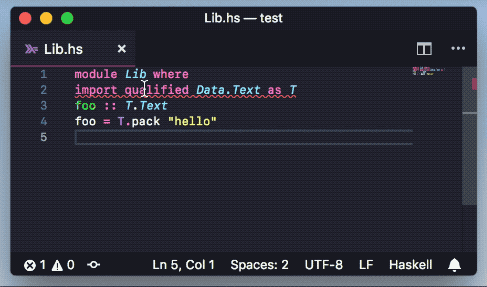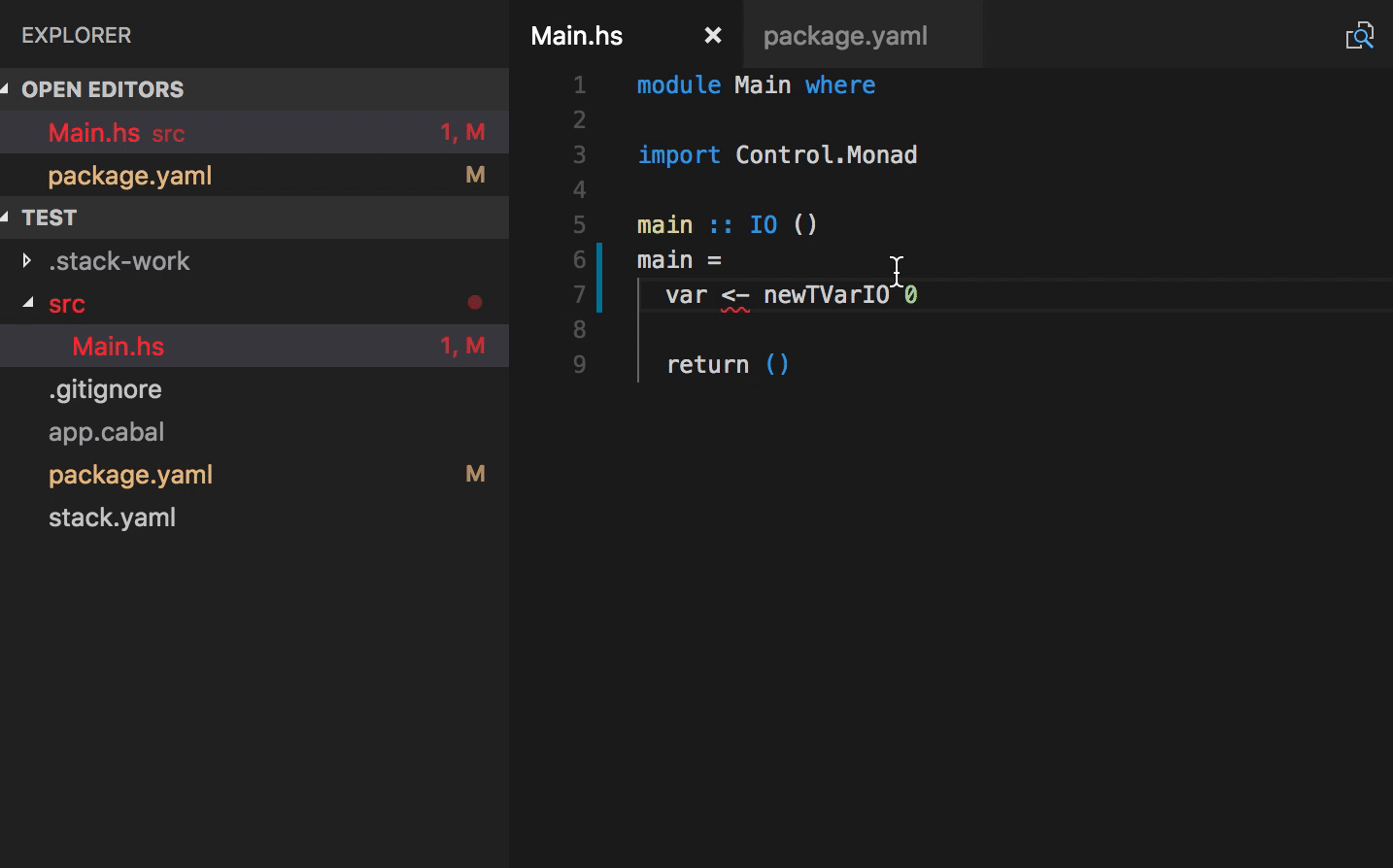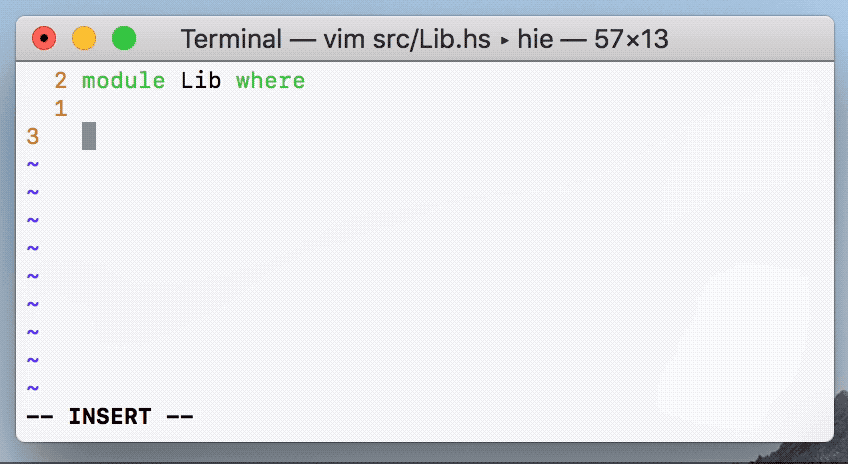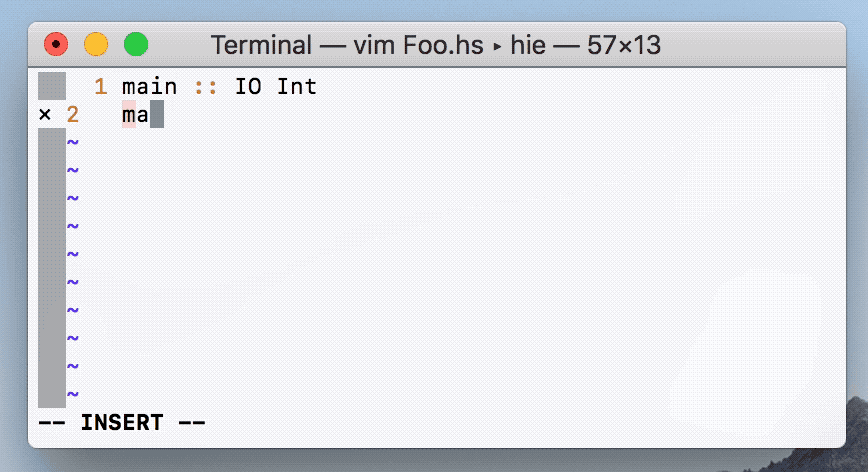|
|
||
|---|---|---|
| .circleci | ||
| app | ||
| docs | ||
| hie-plugin-api | ||
| licenses | ||
| logos | ||
| src/Haskell/Ide/Engine | ||
| submodules | ||
| test | ||
| .gitignore | ||
| .gitmodules | ||
| appveyor.yml | ||
| cabal.project | ||
| Changelog.md | ||
| haskell-ide-engine.cabal | ||
| LICENSE | ||
| make-build-all.bat | ||
| Makefile | ||
| README.md | ||
| Setup.hs | ||
| stack-8.2.1.yaml | ||
| stack-8.2.2.yaml | ||
| stack-8.4.2.yaml | ||
| stack-8.4.3.yaml | ||
| stack.yaml | ||
Haskell IDE Engine

This project aims to be the universal interface to a growing number of Haskell tools, providing a full-featured and easy to query backend for editors and IDEs that require Haskell-specific functionality.
We are currently focusing on using the Language Server Protocol as the interface via which we talk to clients.
- Haskell IDE Engine
Features
-
Supports plain GHC projects, cabal projects(sandboxed and non sandboxed) and stack projects
-
Fast due to caching of compile info
-
Uses LSP, so should be easy to integrate with a wide selection of editors
-
Diagnostics via hlint and GHC warnings/errors
-
Code actions and quick fixes via apply-refact
-
Type information and documentation(via haddock) on hover
-
Jump to definition
-
List all top level definitions
-
Highlight references in document
-
Completion
-
Formatting via brittany
-
Renaming via HaRe
-
Add packages to cabal and hpack package files
-
Typo quick fixes
-
Add missing imports (via hsimport)
Installation
Note: The version on branch hie-0.1.0.0 supports GHC 8.0.2. This is
not supported in master.
On linux derivatives you will need to do the equivalent of before building
sudo apt install libicu-dev libtinfo-dev
Getting the source for GHC 8.2.1, 8.2.2, 8.4.2, 8.4.3
HIE builds from source code, so first,
$ git clone https://github.com/haskell/haskell-ide-engine --recursive
$ cd haskell-ide-engine
Getting the source for GHC 8.0.2
HIE builds from source code, so first,
$ git clone https://github.com/haskell/haskell-ide-engine
$ cd haskell-ide-engine
$ git checkout hie-0.1.0.0
$ git submodule update --init
Installation with stack
To install HIE, you need Stack version >= 1.7.1
In order to support both stack and cabal, hie requires cabal-install
as well.
If it is not already installed, install it, one of the ways is
stack install cabal-install
To install all supported GHC versions, name them as expected by the VS Code
plugin, and also build a local hoogle database, you need the make tool (on
Windows, see the further advice below). Use the command:
make build-all
Then add
"languageServerHaskell.useHieWrapper": true
to VS Code user settings.
Otherwise, do one of the following.
For GHC 8.4.3
Using master
stack install
For GHC 8.4.2
Using master
stack --stack-yaml=stack-8.4.2.yaml install
For GHC 8.2.2
Using master
stack --stack-yaml=stack-8.2.2.yaml install
Using branch hie-0.1.0.0
stack install
For GHC 8.2.1
stack --stack-yaml=stack-8.2.1.yaml install
For GHC 8.0.2 (only via branch hie-0.1.0.0)
stack --stack-yaml=stack-8.0.2.yaml install
Installation on Windows
The make tool
If the make tool is not already available on your path (in Command Prompt, try
commands where make or stack exec where -- make to investigate; in
PowerShell, try where.exe make or stack exec where -- make), it can be added
to the stack environment with the command:
stack exec pacman -- -S make
The make build-all command is then accessible using the command:
stack exec make -- build-all
For users of Cygwin, the Cygwin installer also
provides the make tool as an option.
Alternatively, the Windows batch file make-build-all.bat can substitute for
make build-all on systems without the make command.
Long paths
In order to avoid problems with long paths on Windows you can do the following:
-
Edit the group policy: set "Enable Win32 long paths" to "Enabled". Works only for Windows 10
-
Clone the
haskell-ide-engineto the root of your logical drive (e.g. toE:\hie)
Installation with Nix
Follow the instructions at https://github.com/domenkozar/hie-nix
ArchLinux
An haskell-ide-engine-git package is available on the AUR.
Using Aura:
# aura -A haskell-ide-engine-git
Configuration
There are some settings that can be configured via a settings.json file:
{
"languageServerHaskell": {
"hlintOn": Boolean,
"maxNumberOfProblems": Number
}
}
- VS Code: These settings will show up in the settings window
- LanguageClient-neovim: Create this file in
$projectdir/.vim/settings.jsonor setg:LanguageClient_settingsPath
Editor Integration
Note to editor integrators: there is now a hie-wrapper executable, which is installed alongside the hie executable. When this is invoked in the project root directory, it attempts to work out the GHC version used in the project, and then launch the matching hie executable.
All of the editor integrations assume that you have already installed HIE (see above) and that stack put the hie binary in your path (usually ~/.local/bin on linux and macOS).
Using HIE with VS Code
Install from the VSCode marketplace, or manually from the repository vscode-hie-server.
Using VS Code with Nix
.config/nixpkgs/config.nix sample:
with import <nixpkgs> {};
let
hie = (import (fetchFromGitHub {
owner="domenkozar";
repo="hie-nix";
rev="e3113da";
sha256="05rkzjvzywsg66iafm84xgjlkf27yfbagrdcb8sc9fd59hrzyiqk";
}) {}).hie84;
in
{
allowUnfree = true;
packageOverrides = pkgs: rec {
vscode = pkgs.vscode.overrideDerivation (old: {
postFixup = old.postFixup + ''
wrapProgram $out/bin/code --prefix PATH : ${lib.makeBinPath [hie]}
'';
});
};
}
Using HIE with Sublime Text
- Make sure HIE is installed (see above) and that the directory stack put the
hiebinary in is in your path- (usually
~/.local/binon unix)
- (usually
- Install LSP using Package Control
- From Sublime Text, press Command+Shift+P and search for Preferences: LSP Settings
- Paste in these settings. Make sure to change the command path to your
hie
"clients": {
"haskell-ide-engine": {
"command": ["hie"],
"scopes": ["source.haskell"],
"syntaxes": ["Packages/Haskell/Haskell.sublime-syntax"],
"languageId": "haskell",
},
},
Now open a haskell project with Sublime Text. You should have these features available to you:
- Errors are underlined in red
- LSP: Show Diagnostics will show a list of hints and errors
- LSP: Format Document will prettify the file
Using HIE with Vim or Neovim
As above, make sure HIE is installed. These instructions are for using the LanguageClient-neovim client.
vim-plug
If you use vim-plug, then you can do this by e.g.
including the following line in the Plug section of your init.vim:
Plug 'autozimu/LanguageClient-neovim', {
\ 'branch': 'next',
\ 'do': './install.sh'
\ }
and issuing a :PlugInstall command within neovim.
Vim 8.0
Clone LanguageClient-neovim
into ~/.vim/pack/XXX/start/, where XXX is just a name for your "plugin suite".
Sample ~/.vimrc
set rtp+=~/.vim/pack/XXX/start/LanguageClient-neovim
let g:LanguageClient_serverCommands = { 'haskell': ['hie-wrapper'] }
You'll probably want to add some mappings for common commands:
nnoremap <F5> :call LanguageClient_contextMenu()<CR>
map <Leader>lk :call LanguageClient#textDocument_hover()<CR>
map <Leader>lg :call LanguageClient#textDocument_definition()<CR>
map <Leader>lr :call LanguageClient#textDocument_rename()<CR>
map <Leader>lf :call LanguageClient#textDocument_formatting()<CR>
map <Leader>lb :call LanguageClient#textDocument_references()<CR>
map <Leader>la :call LanguageClient#textDocument_codeAction()<CR>
map <Leader>ls :call LanguageClient#textDocument_documentSymbol()<CR>
Use Ctrl+xCtrl+o (<C-x><C-o>) to open up the auto-complete menu,
or for asynchronous auto-completion, follow the setup instructions on
LanguageClient.
If you'd like diagnostics to be highlighted, add a highlight group for ALEError/ALEWarning/ALEInfo,
or customize g:LanguageClient_diagnosticsDisplay:
hi link ALEError Error
hi Warning term=underline cterm=underline ctermfg=Yellow gui=undercurl guisp=Gold
hi link ALEWarning Warning
hi link ALEInfo SpellCap
If you're finding that the server isn't starting at the correct project root, it may also be helpful to also specify root markers:
let g:LanguageClient_rootMarkers = ['*.cabal', 'stack.yaml']
Using HIE with Atom
Make sure HIE is installed, then install the two Atom packages atom-ide-ui and ide-haskell-hie,
$ apm install language-haskell atom-ide-ui ide-haskell-hie
Using HIE with Emacs
Install HIE along with the following emacs packages:
Make sure to follow the instructions in the README of each of these packages.
Using HIE with Spacemacs
Install HIE, and then add the following to your .spacemacs config,
(defun dotspacemacs/layers ()
"..."
(setq-default
;; ...
dotspacemacs-configuration-layers
'(
lsp
(haskell :variables ;; Or optionally just haskell without the variables.
haskell-completion-backend 'ghci
haskell-process-type 'stack-ghci)
)
dotspacemacs-additional-packages '(
(lsp-haskell :location (recipe :fetcher github :repo "emacs-lsp/lsp-haskell"))
)
;; ...
))
and then activate lsp-haskell in your user-config section,
(defun dotspacemacs/user-config ()
"..."
(require 'lsp-haskell)
(add-hook 'haskell-mode-hook #'lsp-haskell-enable)
)
Now you should be able to use HIE in Spacemacs. I still recommend checking out lsp-ui and lsp-mode.
Using HIE with Oni
Oni (a Neovim GUI) added built-in support for HIE, using stack, in #1918. If you need to change the configuration for HIE, you can overwrite the following settings in your ~/.config/oni/config.tsx file (accessible via the command palette and Configuration: Edit User Config),
export const configuration = {
"language.haskell.languageServer.command": "stack",
"language.haskell.languageServer.arguments": ["exec", "--", "hie"],
"language.haskell.languageServer.rootFiles": [".git"],
"language.haskell.languageServer.configuration": {},
}
Docs on hover/completion
HIE supports fetching docs from haddock on hover. It will fallback on using a hoogle db(generally located in ~/.hoogle on linux) if no haddock documentation is found.
To generate haddock documentation for stack projects:
$ cd your-project-directory
$ stack haddock --keep-going
To enable documentation generation for cabal projects, add the following to your ~/.cabal/config
documentation: True
To generate a hoogle database that hie can use
$ cd haskell-ide-engine
$ stack --stack-yaml=<stack.yaml you used to build hie> exec hoogle generate
Contributing
Planned Features
- Multiproject support
- Project wide references
- Cross project find definition
- New-build support
- HaRe refactorings
- More code actions
- Cross project/dependency Find Definition
- Case splitting, type insertion etc.
This is not yet another ghc-mod or ide-backend project
Both the ghc-mod and ide-backend maintainers have agreed to contribute code to this new repository and then rebase the old repos on this. The reason we're using a new repo instead of modifying one of the existing ones is so that the existing projects experience no disruption during this migration process. If this was a new set of people starting a new project without support from existing projects, I'd agree with you. But Alan's reached out to existing players already, which is an important distinction.
This project is not started from scratch:
- See why we should supersede previous tools
- Check the list of existing tools and functionality
- See more other tools and IDEs for inspiration
It's time to join the project!
❤️ Haskell tooling dream is near, we need your help! ❤️
- Register in our google group mailing list.
- Join our IRC channel at
#haskell-ide-engineonfreenode. - Fork this repo and hack as much as you can.
- Ask @alanz or @hvr to join the project.
Architecture
Below you find a short overview of the main architectural layers of haskell-ide-engine.
For more info have a look in the docs folder at the root of this project, especially:
1. BIOS layer
ghc-mod stays an AGPL project,
and is used for its "awesome sauce" in terms of
the BIOS functions that it does so well. This interface is
straightforward to use,
and if a license-constrained user wants to do something else it is also easy to
replace, if there is strong control of the operating environment.
2. Plugin layer
A layer providing a point to integrate tools and existing functions, probably including ghci.
3. IDE interfacing layer
The focus is currently on LSP as the protocol we use to interface with IDEs.
Existing transports are still functional for the time being.
Documentation
All the documentation is in the docs folder at the root of this project.
Troubleshooting
macOS: Got error while processing diagnostics: unable to load package integer-gmp-1.0.2.0
Rename the file at ~/.stack/programs/x86_64-osx/ghc-8.4.3/lib/ghc-8.4.3/integer-gmp-1.0.2.0/HSinteger-gmp-1.0.2.0.o to a temporary name.
Should be fixed in GHC 8.8.1.





